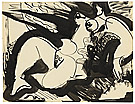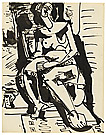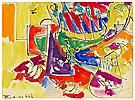Hans HOFMANN
Johann Georg Albert Hofmann was born on 21 March 1880 in Weissenburg, Bavaria. His family moved to Munich in 1886. At school Hofmann excelled in science, but confounded his parents by going on to enrol at Moritz Heymann’s art school, Munich. He attended classes at the Académie de la Grande Chaumièrebetween 1904 and 1906. He remained in Paris until 1914 and was familiar with many influential artists including Henri Matisse, Pablo Picasso and Georges Braque. Jules Pascin and Robert Delaunay became his good friends. In 1909 Hofmann showed with the New secession group at Galerie Der Sturm, Berlin, and, in 1910, held his first solo exhibition at the Paul Cassirer Gallery, Berlin. Kept out of active service by a lung condition, he opened an art school in Munich in 1915. The Schule für Moderne Kunst was an immediate success, attracting many foreign students, particularly Americans.
In 1930, at the invitation of one of his former students, the American Worth Ryder, Hofmann taught at the summer school of the University of California, Berkeley, and returned to teach a second summer session at Berkeley in 1931. His first exhibition in the United States, consisting of drawings, was held that year at the California Palace of the Legion of Honor in San Francisco. Responding to the changing political climate in Germany, Hofmann closed his school in Munich in 1932 and moved to the United States permanently. In 1934 the Hans Hofmann School of Fine Arts opened in New York. A summer school in Provincetown, Massachusetts, was set up in 1935. Hofmann continued teaching at his school for an unbroken period of 24 years, while also exhibiting his own work.
His first solo exhibition was in New York in 1944, at Peggy Guggenheim’s Art of This Century Gallery and, from 1947 until his death, he held solo exhibitions almost every year at Kootz Gallery, New York. A retrospective of his work was shown at the Whitney Museum of American Art, New York, in 1957. The following year, Hofmann closed his school and devoted himself to painting full-time. In 1960 he was one of four artists—with Philip Guston, Franz Kline and Theodore Roszak—who were chosen to represent the United States at the Venice biennale. The Museum of Modern Art, New York, organised a retrospective exhibition of Hofmann’s wok in 1963, which toured the United States, South America and Europe. Hofmann died in New York on 17 February 1966.





